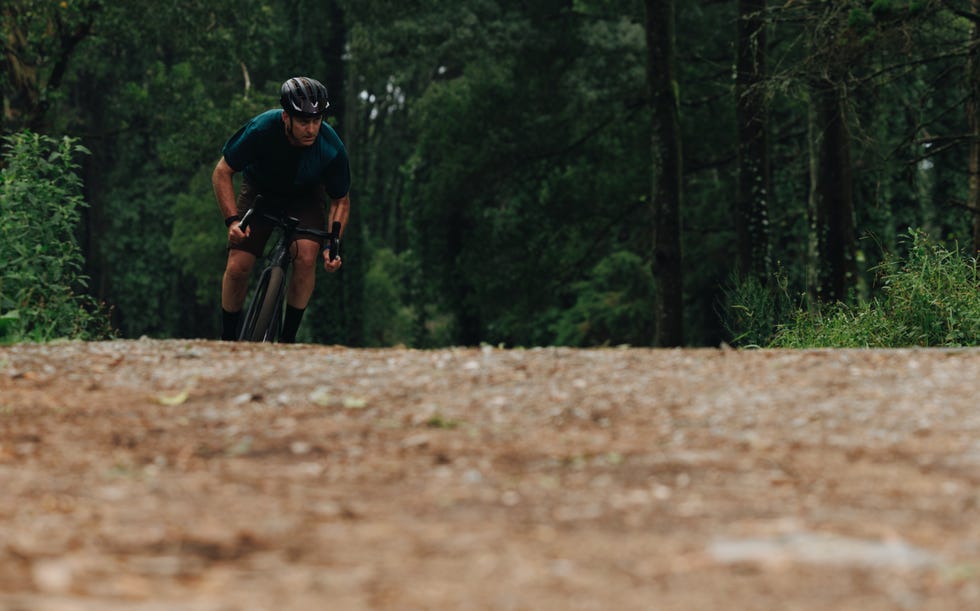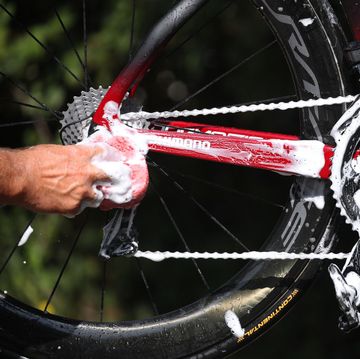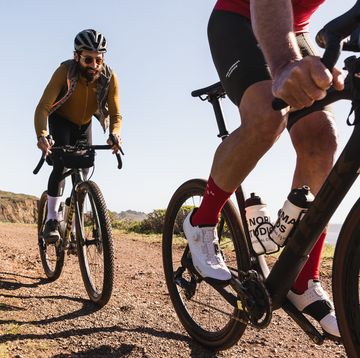The Takeaway: The new Specialized Creo SL 2 departs from the original and groundbreaking V1 Creo. Not only does the Creo 2 use a new and more powerful motor, but it also has new geometry and build kits that are more gravel and off-road focused.
New Purpose?
Version two of the Creo is more than just slapping in the new SL 1.2 motor that debuted in the Levo SL mountain bike. The Creo 2 also has new geometry, features, and build kits. Put together, the V2 Creo looks like a bike built for a different purpose than the Creo V1.
I made an Excel table that lets us compare the geometry of the new Creo SL (in red) to the V1 Creo. Plus, I added the Diverge and Crux gravel bikes and the Roubaix and Tarmac road bikes.
As the table illustrates, the Creo V1 went from a road-ish geometry to something more akin to Specialized’s gravel bikes. In fact, the new Creo is longer and slacker than the Crux or Diverge.
Also updated is tire clearance, which now tops out at 56mm (2.2 inches; V1 had 42mm max clearance). This is enough clearance for a knobby mountain bike tire. Even with fenders, the Creo fits a sizable tire: Up to 47mm, which is wider than the V1 fit without fenders. The minimum recommended tire size is now 38mm: 10mm wider than the tires that came on the V1 Creo.
All V2 builds use dropper posts, gravel wheels wrapped in 47c Tracer Pro semi-knob gravel tires, riser road bars with 12-degree flare, and SRAM drivetrains with wide range 10/11-50-tooth cassettes and 44T chainrings. Look closer, and you also find front and rear rack mounts.
The V1 Creo I tested in 2019 had 50mm deep racing wheels, 28mm tires, a rigid carbon seatpost, an un-flared handlebar, an 11-46T cassette, and a 46T chainring.
So, the new Creo SL is an e-gravel bike? I posed that question to Specialized representatives, and they said no.
In their opinion, Specialized added more capability to the Creo without taking anything away from its road-going performance. For the stock 47c gravel tires, for example, brand representatives argued that there is no tradeoff to ride them on the road on the V2 Creo. They say the added comfort is a net benefit on the road.
Granted, the cycling world has awoken to the benefits of riding wider and lower-pressure tires on the road. (And for my riding, a road bike with anything skinnier than a 32mm tire now seems like a novelty.) But tires play a huge role in how a bike feels. A bike with wider tires feels squishier and less crisp. Must I remind the “Aero is everything” company that a wider tire has more aerodynamic drag—which for e-bikes impacts range?
It seems that Specialized is trying to sell one bike to a wider variety of drop bar e-bike riders. And I don’t know how that will fly when, as bike customers, we got used to bike brands serving up niches upon niches to serve smaller and smaller rider segments.
Maybe I’m too spoiled by all these choices to (fully) appreciate the Creo 2’s versatility and well-rounded performance. Spoiled or not, the new positioning of the Creo opens up a potential opportunity in Specialized’s product line for an even more road-focused e-bike than the V1 Creo.
Updated Future Shock
Like the new Roubaix SL8 launched a fortnight earlier, the V2 Creo gets the updated Future Shock 3 front suspension system.
I cover the updates in depth in my Roubaix story. The highlights are more tuning options, better sealing for improved reliability and longevity, and easier serviceability at the dealer lever for quicker turnaround.
The compliance/suspension story at the rear of the V2 Creo is almost entirely limited to wide tires. All Creo models get dropper posts (27.2mm), which are almost universally stiffer riding than a well-designed rigid post.
The S-Works Creo V2 is fitted with a RockShox Reverb XPLR dropper post, which features ActiveRide—a bit of axial movement when the seatpost is part-way into its drop travel.
However, Specialized feels this axial movement goes against its AfterShock suspension philosophy. It posits that seatpost/seat tube movement should be at about a 45-degree angle for maximum benefit.
Even so, when I rode the S-Works model on rougher surfaces, I appreciated the axial compliance offered by the XPLR post. In my opinion, some give is better than no give.
Lighter Frame
While not earth-shattering news, Specialized does claim they found 120-gram weight savings during the V2 redesign. The claimed frame weight is now 1280 grams.
Unlike many other Specialized models (so far), only one 11r carbon frame tier is employed on all Creo V2 announced.
That does leave room for Specialized to introduce a higher-end 12r carbon frame and lower-priced aluminum-framed models in the future.
New Motor
The new Creo SL adopts the Turbo SL 1.2 motor that debuted with the Levo SL mountain bike.
This motor is significantly more powerful than the V1 motor. It has up to 50 Nm of torque (43 percent more than the V1’s 35 Nm) and 320 watts of support (V1 topped out at 240 watts). The 1.2 motor boasts a 12mm narrower Q-Factor (169mm). And it’s six to nine decibels quieter as well.
Specialized claims they made all these improvements without adding any weight. As before, the claimed motor weight is 1,950 grams.
The Mastermind TCU (Turbo Control Unit) LCD accompanies the new motor. This isn’t technically new (some of the model year 2022 V1 Creos got this display), but it is an upgrade from the original LED-light-only display built into the original Creos.
Not only is it nearly as small and low profile as the original TCU, but the new one displays a wealth of information on a customizable screen (examples: range, cadence, rider and bike power, consumption). It also has a built-in altitude sensor and can pair with external sensors like a heart rate strap, drivetrain, and other accessories.
You can also pair it to an external head unit like Garmin, Wahoo, or Hammerhead—the TCU’s location in the top tube is to read on the fly—if you prefer to use a different head unit. Additionally, a new Specialized companion app (it replaces the Mission Control app) lets riders tune the assist modes, push firmware updates, monitor the bike’s status, and customize the display.
The one feature not yet found in the new Specialized app is Smart Control. However, you can still access this feature through Mission Control.
Smart Control lets you input expected ride metrics—distance and total climbing—and set how much battery you want remaining at the end of the ride. With these inputs, the app automatically adjusts assistance as you ride so you finish with the remaining charge you preset. If, like me, you suffer from severe range anxiety when contemplating bigger rides—particularly on e-bikes with smaller batteries— Smart Control is heaven-sent.
Riders control assist modes and flip through the TCU’s data pages, with two small buttons on the bottom of the bar tops.
Range
Battery life and range are always tricky to estimate because it depends on many factors. When I get my long-term test sample, I’ll ride up my test climb to see what I get. Until then, ranges that Specialized claims for riders in the USA (and other regions with a 45 km/h assist limit) are listed below.
Note that while Specialized did bump up the motor’s power significantly, it’s still using the same 320 Wh internal battery (a 160 Wh range extender is also offered). The more powerful motor does seem to cut into battery life. Where the V1 Creo had a claimed range of 80 miles in Eco mode on the internal battery, the V2 Creo claims 43 miles in Eco mode with the internal battery.
However, Specialized claims that the (anonymous) data they collect on Creo rider usage through their companion apps shows an average ride length of 90 minutes. And 90 minutes is exactly the V2 Creo’s claimed range in Turbo mode on the internal battery only (135 minutes with range extender).
Builds, Prices, Claimed Weights
The Creo SL arrives in three builds priced at $6,500, $9,000, and $14,000.
In a stunning revelation in the year 2023, these prices represent a better value as the upgraded V2 sells for the same, or less, than the Creo V1.
For example, the $6,500 V2 Comp Carbon is $750 less than the V1 Comp Carbon. The Expert and S-Works versions are the same price ($9,000 and $14,000, respectively) as the V1 models when they launched in 2019.
All three Creo V2 builds use the same carbon frame and fork, motor, and 320 Wh internal battery. The 160 Wh range extender is included with the S-Works bike but not the other models. The range extender sells for $450 each.
The S-Works and Expert models get the new Future Shock 3.3 with on-the-fly adjustable hydraulic damping. The Creo Comp has Future Shock 3.2, which is hydraulically damped but not adjustable.
Creo SL 2 Comp $6,500
Creo SL 2 Expert $9,000
S-Works Creo SL 2 $14,000
Impressions
I got my first rides on the V2 Creo at the same press event where I got my first rides on the new Roubaix SL8.
While the weather was more cooperative for my rides on the Creo—I got in three—they still were not the most illuminating. So, like the Roubaix, I withhold final judgment until I receive a long-term sample.
The biggest challenge I encountered trying to evaluate the Creo in Portugal was that for two of the three rides, the Creo was set to the European assist limit of 25 km/h (15.5 mph) instead of the US assist limit of 45 km/h (28 mph).
25 km/h, by the way, is lower still than the 32 km/h (20 mph) assist limit class-one mountain bikes in the States.
’Merica!
My rides on the 25 km/h-limited Creo had me feeling a bit sorry for our friends in Europe. The 25 km/h limit doesn’t help you to keep up with group rides. I found it easy to exceed the assist limit on flat paved roads. This left me pedaling around an un-aerodynamic and sluggish 30-pound bike fitted with squishy and draggy 47mm tires solely with my power. Oof.
With the 25 km/h limit, I found the assist relegated to helping accelerate from stops and helping on climbs.
That’s certainly something, but the Creo is a very different bike and riding experience with a 45 km/h assist limit than a 25 km/h limit.
The one ride I got on the new Creo SL with a 45 km/h assist limit was much more yee-haw, and it reminded me of what I loved about the original Creo. As I found on the second-generation Levo SL, the new motor is noticeably more powerful, with an even smoother and more natural feeling assist—which says something because Specialized’s motor tunes are already the best in the business—and noticeably quieter.
But this is a different bike than the V1 Creo. That bike felt more like a road bike with sharper and crisper handling manners than the V2. V2 Creo is more of a utility vehicle than a race-bred machine—V2 trades some sportiness on pavement for more capability on dirt and gravel roads and trails.
For our rides on the Creo, Specialized selected routes that included significant portions of dirt roads and paths, and some singletrack too: Pavement was essentially used to get us to and connect up to, the “good parts.”
And if you’re looking for an e-bike to do that kind of riding, the Creo SL is quite good. The handling is surefooted on slippy and unpredictable surfaces, and the Future Shock does yeoman’s work, offering noticeable comfort and control benefits. It’s stable and descends off-road terrain very capably.
I feel like Specialized whiffed slightly with the V2’s overall compliance. The 47mm tires do a lot of work here, but when riding on unpaved surfaces, there’s no hiding that this is a stoutly built e-bike frame. And given the V2 Creo’s positioning and build kits, Specialized missed an opportunity to adopt the Diverge STR’s Future Shock rear suspension system onto the Creo.
Overall, I am unsure what to make of the V2 Creo. I ponder if Specialized made V2 Creo more capable and created a bike decent for various things. Yet, I do not have a clear idea of what the Creo 2 wants to be and who it is for.
It feels that Specialized now has a great e-gravel(ish) bike, but the brand no longer has a solution for riders who want an e-road bike. Maybe, hopefully, an e-Roubaix or e-Tarmac is in the works to plug that hole.

A gear editor for his entire career, Matt’s journey to becoming a leading cycling tech journalist started in 1995, and he’s been at it ever since; likely riding more cycling equipment than anyone on the planet along the way. Previous to his time with Bicycling, Matt worked in bike shops as a service manager, mechanic, and sales person. Based in Durango, Colorado, he enjoys riding and testing any and all kinds of bikes, so you’re just as likely to see him on a road bike dressed in Lycra at a Tuesday night worlds ride as you are to find him dressed in a full face helmet and pads riding a bike park on an enduro bike. He doesn’t race often, but he’s game for anything; having entered road races, criteriums, trials competitions, dual slalom, downhill races, enduros, stage races, short track, time trials, and gran fondos. Next up on his to-do list: a multi day bikepacking trip, and an e-bike race.




























































